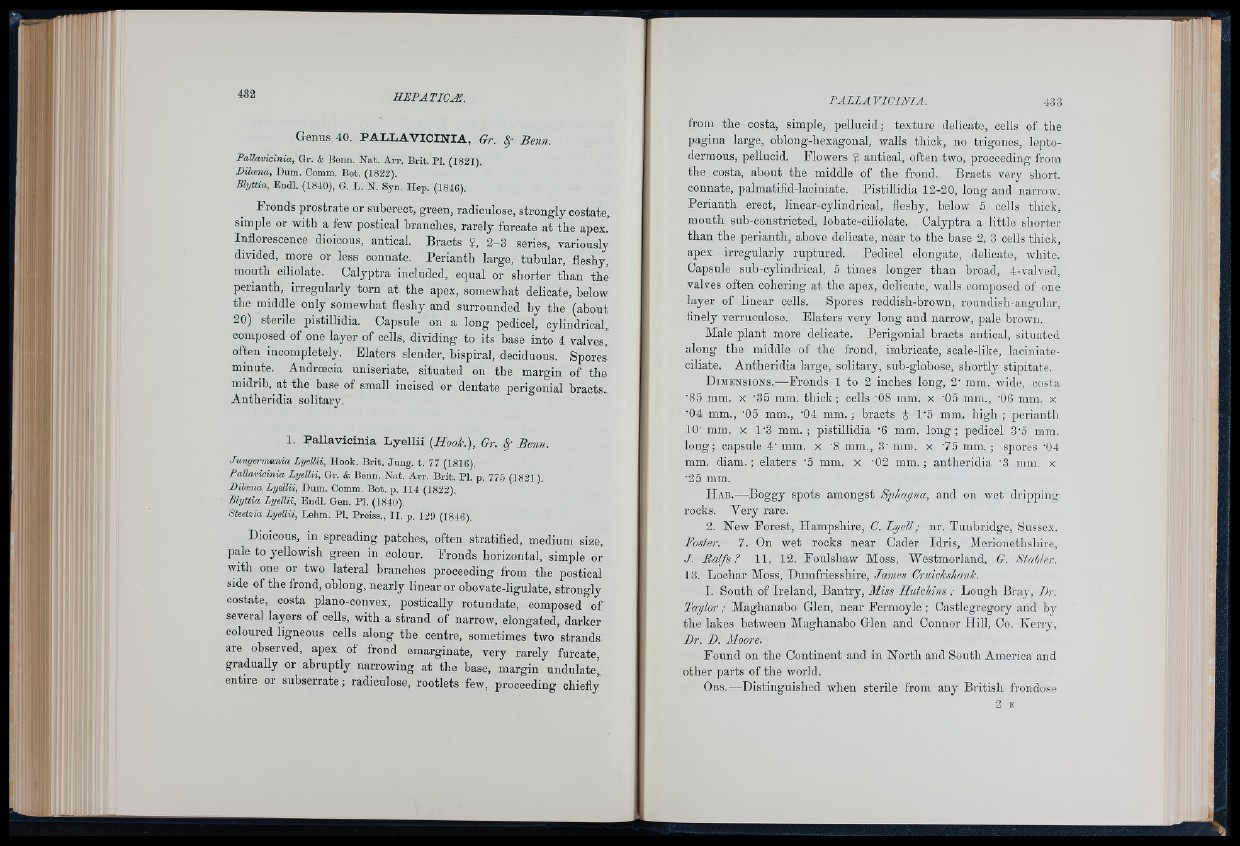
Genus 40. PALLAVICINIA, Gr. fl Benn.
Pallavicinia, Gr. k Benn. N a t. Arr. Brit. Pl. (1821).
Dilcena, Dum. Comm. Bot. (1822).
Blyttia, Endl. (1840), G, L. N. Syn. Hep. (184C).
Fronds prostrate or suberect, green, radiculose, strongly costate,
simple or with a few postical branohes, rarely furcate at the apex.
Inflorescence dioicous, antical. Braots ?. 2-3 series, variously
divided, more or less connate. Perianth large, tubular, fleshy,
mouth ciliolate. Calyptra included, equal or shorter than the
perianth, irregularly torn at the apex, somewhat delicate, below
the middle only somewhat fleshy and surrounded by the (about
20) sterile pistillidia. Capsule on a long pedicel, cylindrical,,
composed of one layer of cells, dividing to its base into 4 valves,
often incompletely. Elaters slender, bispiral, deciduous. Spores
minute. Androecia uniseriate, situated on the margin of the
midrib, at the base of small incised or dentate perigonial bracts..
Antheridia solitaiy.
1. Pallavicinia L y e llii [Hook.), Gr. fl Benn.
■Tungennania Lyellii, Hook. B rit. Ju n g . t. 77 (181G).
Pallavioinia Lyellii, Gr. k Benn. Nat. A rr. B rit. PI. p. 775 (1821 ).
Dihaia Lyellii, Dum. Comm. Bot. p. 114 (1822).
Blyttia Lyellii, Endl. Gen. PI. (1840).
Sleetzia Lyellii, Lelim. PI. Preiss., I I . p. 12!) (1846).
Dioicous, in spreading patches, often stratified, medium size,
pale to yellowish green in colour. Fronds horizontal, simple or
with one or two lateral branches proceeding from the postical
side of the frond, oblong, nearly linear or obovate-ligulate, strongly
costate, costa plano-convex, postically rotundate, composed o f
several layers of cells, with a strand of narrow, elongated, darker
coloured ligneous cells along the centre, sometimes tivo strands
are observed, apex of frond emarginate, very rarely furcate
gradually or abruptly narrowing at the base, margin undulate!
entire or subserrate; radiculose, rootlets few, proceeding chiefly
from the costa, simple, pellucid; texture delicate, cells of the
pagina large, oblong-hexagonal, walls thick, no trigones, lepto-
dermoiis, pellucid. Flowers $ antioal, often two, proceeding from
the costa, about the middle of the frond. Braots very short,
connate, palmatifid-laoiniate. Pistillidia 12-20, long and narrow.
Perianth erect, linear-cylindrical, fleshy, below 5 cells thick,
mouth sub-constricted, lobate-oiliolate. Calyptra a little shorter
than the perianth, above delicate, near to the base 2, 3 cells thick,
apex irregularly ruptured. Pedicel elongate, delicate, white.
Capsule sub-cylindrical, 5 times longer than broad, 4-valved,
valves often cohering at the apex, delicate, walls composed of one
layer of linear cells. Spores reddish-brown, roundish-angular,
finely verruculose. Elaters very long and narrow, pale brown.
Male plant more delicate. Perigonial bracts antical, situated
along the middle of the frond, imbricate, scale-like, laciniate-
ciliate. Antheridia large, solitary, sub-globose, shortly stipitate.
D im e n s io n s .—Pronds 1 to 2 inches long, 2 ’ mm. wide, costa
•85 mm. x '35 mm. thick; cells •OS mm. x •OS mm., •06 mm. x
■04 mm., -05 mm., -04 mm. ; braots i 1-5 mm. high ; perianth
10^ mm. X 1^3 mm.; pistillidia '6 mm. long; pedicel 3^5 mm.
long; capsule 4' mm. x •S mm., mm. x 75 mm. ; spores -04
mm. diam.; elaters '5 mm. x -02 mm.; antheridia '3 mm. x
•25 mm.
H a b .— Boggy spots amongst Sphagna, and on wet dripping
rocks. Very rare.
2. New Forest, Hampshire, C. Lgell; nr. Tunbridge, Sussex.
Foster. 7. On wet rocks near Cader Idris, Merionethshii-e,
■T. Rolfs? 11, 12. Foulshaw Moss, Westmorland, G. Stabler.
13. Lochar Moss, Dumfriesshire, James Cruickshank.
I. South of Ireland, Bantry, Miss Hutchins; Lough Bray, Dr.
Taylor; Maghanabo Glen, near Fermoyle ; Castlegregory and by
the lakes between Maghanabo Glen and Connor Hill, Co. Kerry,
Dr. D. Moore.
Found on the Continent and in North and South America and
other parts of the world.
O b s .— Distinguished when sterile from any British frondose
2 E